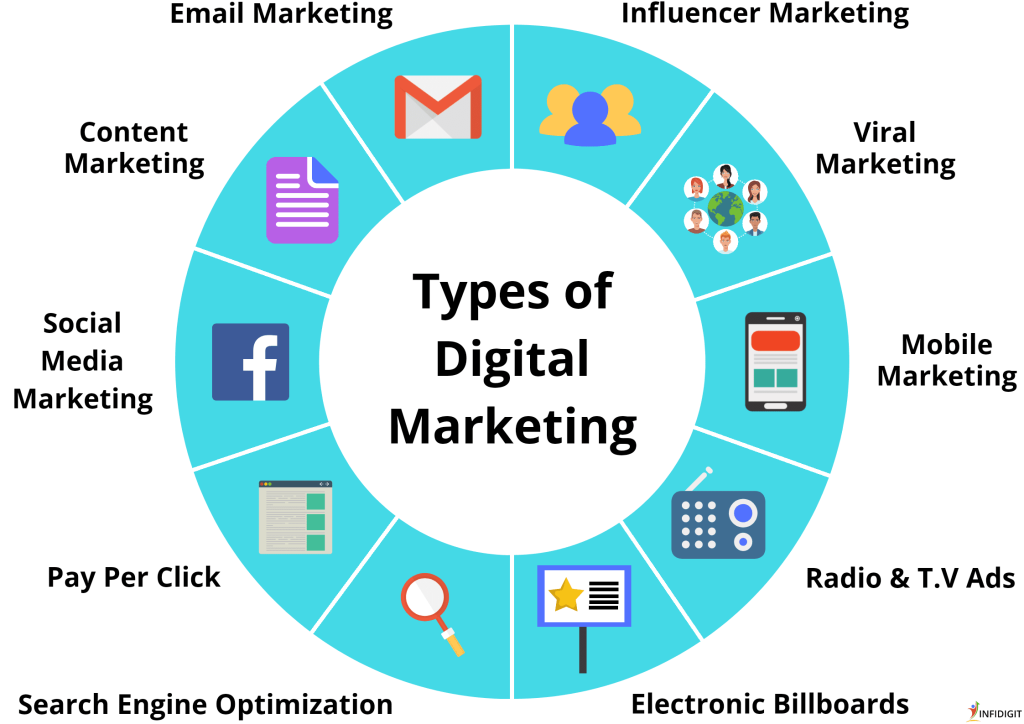What is Digital Marketing?

Digital marketing is the practice of promoting and selling products or services using digital technologies, such as the internet, social media, search engines, mobile devices, and other digital channels. It includes a range of strategies and techniques, such as search engine optimization (SEO), social media marketing, email marketing, content marketing, pay-per-click (PPC) advertising, and more.
The goal of digital marketing is to reach a target audience, engage with them, and ultimately convert them into customers. It provides businesses with an effective and measurable way to reach their target audience, build brand awareness, and increase sales. Digital marketing is essential in today’s digital age, where more and more consumers are using digital channels to research and purchase products and services.
Strategy of Digital Marketing

Digital marketing continues to grow in importance. People are spending more than time online, and marketing budgets continue to shift toward digital innovation. With so many opportunities in digital marketing, it is easy to get into execution mode and just start doing. However, investing in your strategy is one of the best ways to grow your digital return on investment. A clear strategy reduces waste, adds focus to your efforts and builds on what is already working.
Creating a digital marketing strategy involves several steps that help define your goals, target audience, tactics, and metrics for success.
Here is a general framework to help you create a digital marketing strategy:
- Define your goals: Start by defining what you want to achieve with your digital marketing efforts. Are you looking to increase brand awareness, generate leads, increase sales, or build customer loyalty? Your goals will shape the rest of your strategy.
- Understand your target audience: Know who your ideal customers are, what their needs and interests are, and how they interact with your brand online. Use customer surveys, analytics data, and social media listening to gather insights.
- Conduct a competitive analysis: Research your competitors and identify their strengths, weaknesses, and tactics. This will help you differentiate your brand and develop a unique selling proposition.
- Choose your digital marketing channels: Determine which channels (e.g., social media, email, search engine marketing, content marketing) are most effective for reaching your target audience and achieving your goals.
- Develop a content strategy: Create a content plan that aligns with your goals and channels. Determine what types of content (e.g., blog posts, videos, info graphics) you will create and how often you will publish them.
- Create a budget: Decide how much you will invest in each channel and tactic, and allocate your budget accordingly.
- Set metrics and K Pis: Define the key performance indicators (KPIs) that you will use to measure the success of your digital marketing efforts. Examples include website traffic, social media engagement, leads generated, and sales revenue.
- Test and optimize: Continuously test and optimize your tactics to improve performance. Analyze your metrics, identify areas for improvement, and make changes as needed.
How many types of digital marketing are there?

There are several types of digital marketing, each with its own unique benefits and strategies. Here are some of the most common types of digital marketing:
- Search Engine Optimization (SEO): The practice of optimizing website content and structure to rank higher in search engine results pages (SERPs).
- Search Engine Marketing (SEM): Using paid search advertising to drive traffic to a website, typically through platforms such as Google Ads.
- Social Media Marketing: Promoting products or services on social media platforms, such as Facebook, Instagram, Twitter, and LinkedIn.
- Email Marketing: Sending promotional messages or newsletters via email to a target audience.
- Content Marketing: Creating and sharing valuable and informative content to attract and engage with a target audience.
- Influencer Marketing: Partnering with social media influencers to promote products or services to their followers.
- Affiliate Marketing: Rewarding affiliates for promoting and driving traffic to a company’s website or products.
- Video Marketing: Creating and promoting video content to reach and engage with a target audience.
- Mobile Marketing: Reaching and engaging with a target audience on mobile devices, typically through mobile-optimized websites and apps.
Each of these types of digital marketing has its own unique strategies and techniques, and many businesses use a combination of these approaches to achieve their marketing goals.
Thanks,






Leave a Reply
You must be logged in to post a comment.